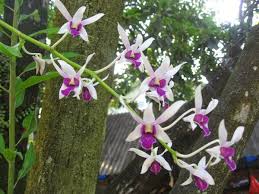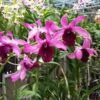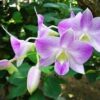# Caring for Dendrobium Orchids in Limited Spaces: Techniques and Tips

Dendrobium orchids, with their stunning flowers and versatility, have become a popular choice for both novice and experienced gardeners. However, for those living in urban environments or smaller homes, caring for these exquisite plants in limited spaces can be a challenge. This article explores effective techniques for nurturing Dendrobium orchids in confined areas, providing valuable insights into optimal care, potting, lighting, watering, fertilization, pest management, and more.
## Understanding Dendrobium Orchids
### Characteristics of Dendrobium Orchids
Dendrobium is a diverse genus within the Orchidaceae family, featuring over 1,800 species and countless hybrids. They are known for their wide range of flower colors, shapes, and sizes. Common characteristics include:
– **Growth Habit**: Dendrobiums can grow as epiphytes, lithophytes, or terrestrial plants, depending on the species. Their adaptability allows them to thrive in various environments.
– **Pseudobulbs**: Many Dendrobiums feature pseudobulbs, which store water and nutrients. These structures play a crucial role in their survival, especially in limited water conditions.
– **Flowering Patterns**: Dendrobiums typically bloom once a year, with flowering durations varying by species. Their stunning blossoms can last several weeks, making them attractive for indoor settings.
### Popular Dendrobium Varieties for Limited Spaces
When selecting Dendrobium orchids for small spaces, consider compact varieties that won’t outgrow their environment. Some suitable options include:
– **Dendrobium Nobile**: Known for its fragrant flowers, this species typically grows to about 2 feet tall and can be grown in smaller pots.
– **Dendrobium Phalaenopsis**: This hybrid resembles the popular Phalaenopsis orchid, featuring beautiful, large flowers on shorter stems. It is well-suited for indoor cultivation.
– **Dendrobium Crumenatum**: Also known as the pigeon orchid, this compact species can grow well in limited spaces and produces clusters of delicate flowers.
## Creating an Ideal Growing Environment
### 1. Selecting the Right Location
Choosing the best location for your Dendrobium orchids is essential, especially in limited spaces. Here are some tips:
– **Bright, Indirect Light**: Dendrobiums thrive in bright, indirect light. Place them near windows with filtered sunlight, avoiding direct sunlight, which can scorch their leaves.
– **Avoid Drafts and Extremes**: Keep orchids away from drafty windows or heating/cooling vents to prevent temperature fluctuations that can stress the plants.
– **Humidity Considerations**: Dendrobiums prefer humidity levels between 40% and 60%. Consider using a humidity tray or a small humidifier to maintain optimal conditions.
### 2. Utilizing Vertical Space
In limited areas, vertical gardening can maximize space while creating an attractive display. Here’s how to incorporate Dendrobium orchids into a vertical setup:
– **Wall-mounted Planters**: Install wall-mounted planters or shelves to showcase your Dendrobiums at varying heights. This approach not only saves floor space but also enhances aesthetics.
– **Hanging Baskets**: Use hanging baskets or pots to suspend Dendrobiums from ceilings or hooks. This method is particularly effective for trailing varieties, creating a cascading effect.
### 3. Choosing Appropriate Containers
Selecting the right pots is crucial for Dendrobium health, especially in limited spaces. Consider the following:
– **Size Matters**: Choose pots that are appropriately sized for your Dendrobiums. Too large pots can retain excess moisture, leading to root rot, while too small pots may restrict root growth.
– **Drainage is Key**: Ensure that pots have adequate drainage holes to prevent waterlogging. Consider using pots made from materials that allow airflow, such as terracotta or clay.
– **Decorative Options**: Opt for decorative pots that complement your interior design. Attractive containers can enhance the overall appeal of your Dendrobium display.
## Watering Techniques for Limited Spaces
### 1. Understanding Watering Needs
Dendrobium orchids have specific watering needs that must be addressed, especially in small spaces. Here are some key considerations:
– **Soil Moisture**: Dendrobiums prefer to dry out slightly between waterings. Check the potting medium’s moisture level by inserting your finger about an inch deep; if it feels dry, it’s time to water.
– **Seasonal Adjustments**: Watering frequency may change with the seasons. During active growth (spring and summer), Dendrobiums will require more frequent watering, while in winter, they may need less.
### 2. Effective Watering Methods
When watering Dendrobiums in limited spaces, consider the following techniques:
– **Bottom Watering**: Place pots in a shallow tray of water, allowing the plant to absorb moisture from the bottom. This method prevents overwatering and ensures even hydration.
– **Use a Spray Bottle**: For orchids in small pots, using a spray bottle can help control the amount of water applied. Mist the potting medium lightly without saturating it.
– **Watering Can with a Narrow Spout**: If using a watering can, opt for one with a narrow spout to direct water precisely at the base of the plant, minimizing excess moisture on leaves.
## Fertilization Strategies
### 1. Importance of Fertilization
Proper fertilization is vital for the healthy growth of Dendrobium orchids, especially in confined spaces where nutrient availability may be limited. Key points to consider include:
– **Nutrient Needs**: Dendrobiums benefit from balanced fertilizers with a higher phosphorus content to promote blooming. Look for fertilizers with an N-P-K ratio of 30-10-10 or similar.
– **Frequency**: Fertilize every two to four weeks during the growing season (spring and summer) and reduce or halt during dormancy (fall and winter).
### 2. Fertilization Techniques
Implement the following fertilization techniques to optimize nutrient absorption:
– **Diluted Fertilizer Solutions**: Always dilute fertilizers to half or a quarter strength to prevent burning the roots. This is especially important in smaller pots where nutrients can quickly accumulate.
– **Application Methods**: Use the “soak and dry” method by applying the fertilizer when watering, allowing the roots to absorb nutrients efficiently while avoiding salt buildup.
– **Organic Options**: Consider using organic fertilizers such as fish emulsion or seaweed extract. These options provide slow-release nutrients and improve soil health without risking chemical buildup.
## Pest Management in Limited Spaces
### 1. Common Pests Affecting Dendrobium Orchids
Pests can pose a significant threat to Dendrobium orchids, especially in small spaces where ventilation may be limited. Common pests include:
– **Mealybugs**: These white, cotton-like pests often hide in leaf joints and can weaken the plant.
– **Aphids**: Small, green or black insects that suck sap from the plant, causing stunted growth.
– **Spider Mites**: These tiny pests thrive in dry conditions and can create webbing on leaves, leading to yellowing and leaf drop.
### 2. Prevention and Control Strategies
To effectively manage pests in confined spaces, consider the following strategies:
– **Regular Inspections**: Routinely check your Dendrobiums for signs of pests. Early detection is crucial for effective control.
– **Neem Oil Treatment**: Use neem oil or insecticidal soap as a natural pest control solution. Apply it according to the manufacturer’s instructions, ensuring complete coverage of affected areas.
– **Maintain Cleanliness**: Keep the growing area clean and free of debris. Remove any fallen leaves or dead flowers to reduce potential pest habitats.
– **Air Circulation**: Ensure good air circulation around your plants to deter pests. A small fan can help improve airflow and reduce humidity levels that attract pests.
## Propagation Techniques for Limited Spaces
### 1. Propagating Dendrobium Orchids
Propagating Dendrobium orchids can be a rewarding experience, allowing you to expand your collection without requiring much space. Here are effective methods:
– **Stem Cuttings**: This method involves taking healthy stem cuttings with at least one node and placing them in a suitable potting medium. Ensure the cutting is at least 6 inches long for better rooting.
– **Division**: If your Dendrobium has grown too large for its pot, consider dividing it. Carefully separate the pseudobulbs and repot them into smaller containers.
### 2. Miniature Propagation Techniques
For those with limited space, consider these miniature propagation techniques:
– **Flask Propagation**: Use sterile flasks to create a controlled environment for seedlings. This method allows for higher success rates and requires minimal space.
– **Moss Cups**: Place cuttings in small cups filled with moss to create a humid environment. This technique is particularly effective for root development.
## Enhancing Aesthetics in Limited Spaces
### 1. Creating Attractive Displays
Even in small areas, you can create beautiful displays of Dendrobium orchids. Consider the following tips:
– **Group Plantings**: Cluster different Dendrobium varieties together in pots to create a vibrant display. Choose complementary colors and sizes for visual appeal.
– **Decorative Stands**: Utilize decorative plant stands or shelves to elevate your orchids. This not only saves space but also adds a stylish touch to your indoor decor.
– **Use of Lighting**: Incorporate grow lights to enhance the beauty of your Dendrobium orchids. These lights can provide the necessary light conditions while adding a warm ambiance to the space.
### 2. Incorporating Dendrobium into Interior Design
Dendrobium orchids can enhance your home decor in limited spaces. Consider the
following ideas:
– **Coffee Tables and Side Tables**: Place Dendrobiums in decorative pots on coffee tables or side tables for a pop of color and elegance.
– **Bathroom Decor**: Dendrobiums thrive in humid environments, making them suitable for bathrooms. Place them near windows to provide adequate light.
– **Kitchen Displays**: Brighten up your kitchen with Dendrobium orchids on window sills or countertops. Their beauty can add a refreshing touch to the culinary space.
## Conclusion
Caring for Dendrobium orchids in limited spaces can be a rewarding and fulfilling experience. By understanding their specific needs and employing effective techniques, you can create a thriving environment for these stunning plants, regardless of space constraints. Whether you’re a beginner or an experienced orchid enthusiast, embracing the challenges of limited space will enhance your gardening skills and contribute to the beauty of your home. With the right techniques, your Dendrobium orchids can flourish, bringing joy and elegance to your living space.

